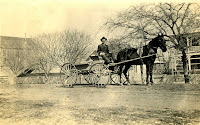 |
| Freight Wagons traveling from Kerrville to Junction, around 1900. Photo courtesy of the Blakely Collection. Click on any image to enlarge. |
Years ago Herbert E. Oehler wrote a book about growing up in the Mountain Home area called “Hill Country Boy,” which my father printed in the early 1980s. I recently found a copy at Wolfmueller's Books which I quickly purchased.
 |
| Leland Richeson in the C C Butt Grocery wagon |
“Travelers who skim over the smooth pavement of IH10 from Kerrville to Junction can easily make it in an hour now,” writes Mr. Oehler. “But there was a time early in [the last] century when the same trip consumed most of a day, sometimes even longer when rain made the road a series of water filled ruts except in those places where uneven rocks cropped to the surface.
 |
| A Surrey Wagon, around 1910, near Kerrville |
'Isenglass,' Gentle Reader, is a substance made from the dried swim bladders of fish.
Oehler’s family’s place was one of the stops on the line. “It was not a passenger station in the usual sense but simply a stop where the horses which had brought the hack from Kerrville were unharnessed and a new team hitched up. The stage line hired a man to do this. He had a tent to live in, pitched under a big walnut tree near the creek. Besides hitching and unhitching the teams, it was his duty to see that the horses were fed, watered, shod and given such other care as required.”
 |
| Tom Tarver getting the mail at the Kerrville Depot, 1933 |
Four horses were used to pull the hack from Kerrville to the Oehler’s place, unless it was rainy; then six were required, just to get the hack through the ruts. “This was particularly true of the Mountain Home to Junction stretch which had not been graveled except in a few places where the mud was especially deep.”
“The fact that this road was also used by freighters who hauled wool and mohair from Junction to Kerrville, and merchandise in the opposite direction, certainly didn’t tend to improve the road since the heavily loaded wagons cut deep ruts into the soft ground.
 |
| Wool Wagons on Water Street, Blakely Collection |
“They were welcome, too, to seek out the little outhouse back near the barn. This was a two-holer, completely equipped with a bucket of corn cobs and a Sears Roebuck catalog. It is doubtful if every outhouse on the stage line gave the passengers such a choice,” Oehler writes proudly.
 |
| Freight Wagons, Earl Garrett at Water Street in Kerrville |
This route crossed Johnson Creek 12 times between Mountain Home and Kerrville (13 crossings if you count the Smith Branch crossing).
Consider that, Gentle Reader. We take for granted the terrain here as we travel in comfort, sealed in our air-conditioned cars, listening to music, and talking on the telephone.
Until next week, all the best.
Joe Herring Jr. is a Kerrville native who can remember traveling to Junction before IH10 was built, along a route which must have been close to that described by Oehler. This column originally appeared in the Kerrville Daily Times January 6, 2018.



Love this as I was born in Junction and my sister was born Mountain Home on a ranch .
ReplyDelete